Aeollanthus rehmannii
Aeollanthus rehmannii Gürke
Family: Lamiaceae
Common names: wavyleaf rocksage (Eng.), klipsalie (Afr.)
Introduction
An appealing perennial, with aromatic leaves with wavy edges and clusters of pink and purple flowers which draw butterflies and bees and bloom from early summer to autumn. Easy to grow it makes a worthwhile, water-wise garden ornamental.
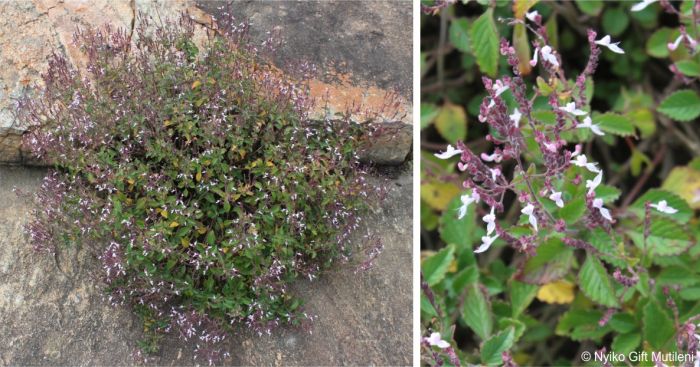
Description
Description
Aeollanthus rehmannii is an aromatic, semi-succulent subshrub or perennial herb 200 to 500 mm tall. It has numerous erect or ascending to spreading stems that are covered in small, recurved hairs. Leaves are softly fleshy, ovate, opposite, 15-35 mm long and 10-22 mm wide. The underside is pale green, has noticeable veins and is densely covered with small stiff hairs, which gives them a rough texture. The upper surfaces of the leaves are generally darker green and smoother, with less pronounced veins. The margin is crenate-dentate, giving the leaf a wavy edge, and is often reddish purple.

White to pinkish-mauve flowers with reddish-purple markings on the upper lip are produced in a branched inflorescence of compact spikes up to 40 mm long, and flowers on the lateral inflorescence stems are frequently one sided. Bracts up to 3.5 mm long. Corolla 7-11mm long, white or pale violet, lower lip boat-shaped, usually darker towards the apex; upper lip almost equally 4-lobed, with vertical rows of dark violet dots. Flowering time is during summer, from August or December to May. The fruit is a little brown nutlet.
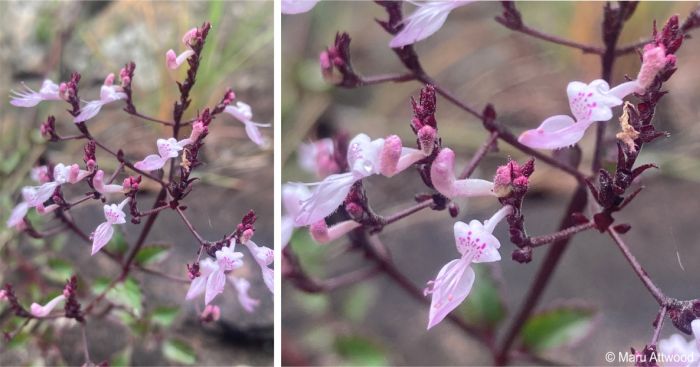
Conservation Status
Status
It is not a threatened species and thus it is assessed as Least Concern (LC) according to the Red List of South African Plants.
Distribution and habitat
Distribution description
Aeollanthus rehmannii is found in the northern regions of southern Africa and beyond. It is native to Angola, Botswana, Eswatini, Malawi, Mozambique, Namibia, South Africa, Tanzania, Zambia and Zimbabwe. In South Africa it is found in Gauteng, KwaZulu-Natal, Limpopo and Mpumalanga. It thrives in pockets of shallow soil among rocks, at elevations of up to 1 700 m. It prefers seasonally dry tropical biomes.
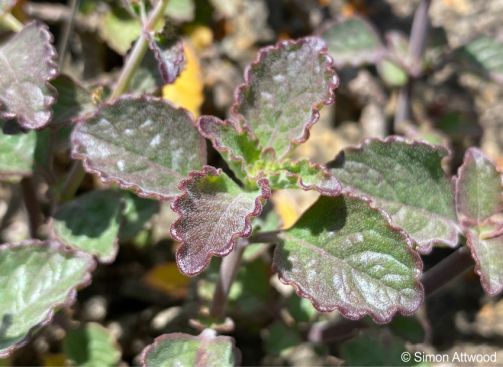
Derivation of name and historical aspects
History
Greek and personal names are combined to give this plant its name. The genus name Aeollanthus refers to the wind-swept environments of certain species in the genus and is derived from the Greek words Aiolos, the god of the wind, and anthos, meaning ‘flower’. The specific name honours Anton Rehmann, a polish botanist who collected the type specimen during his travels in the present-day Limpopo province of South Africa in the late 1870s or early 1880s.In 1896, Gürke described the species in the Bulletin de l’Herbier Boissier, and gave it Rehmann’s name. The plant belongs to the mint family along with Plectranthus, Tetradenia and Ocimum.
Ecology
Ecology
Usually found in seasonally dry tropical biomes, this species thrives in shallow soil pockets among rocks. It is versatile and adaptable, and can flourish in places with poor soil and sometimes hostile conditions. Just like many other plants in the Lamiaceae family, it depends on insects and other pollinators to reproduce. This relationship promotes the health of the ecosystem and helps feed local pollinator populations.
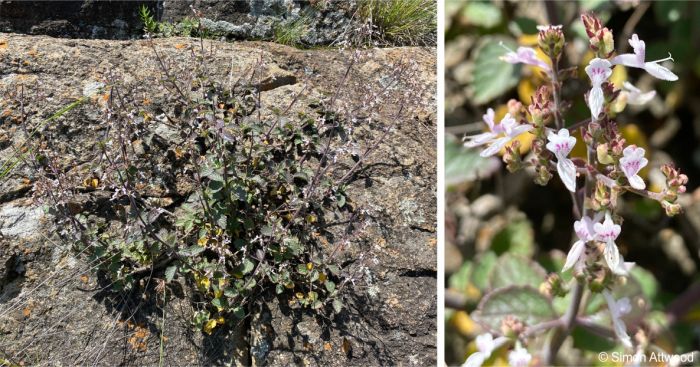
Uses
Use
There are no recorded cultural or medicinal applications for Aeollanthus rehmannii, however other species are used in traditional medicine and it is possible that it may also have some therapeutic properties, e.g. Aeollanthus buchnerianus is used to treat colds by Sotho people, and Aeollanthus suaveolens is used in traditional medicine in tropical Africa, and in Brazil, where it is an introduced and cultivated plant, it is used to treat skin, ear and eye diseases, and stomach complaints.
Because of its eye-catching look, it is also planted as a garden ornamental and is well suited to rockeries.
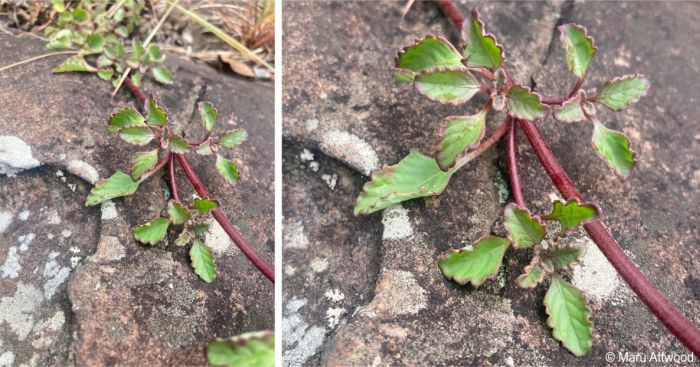
Growing Aeollanthus rehmannii
Grow
Aeollanthus rehmannii is a sun loving plant and it can also withstand some shade, but for best performance it is advised to plant it in an area that receives six hours of direct sunlight each day. The plant may grow lanky and produce fewer flowers if it does not get enough sunshine. It grows well in temperatures between 15-27°C. It need to be protected in winter because it cannot withstand freezing temperatures. Move the plant indoors or to a warm spot before frost arrives if it is grown in a container. Plants require well-drained soil with a slightly acidic to neutral pH. Although it may grow in a variety of soil types, it prefers sandy fertile soil. To enhance the structure of the soil and supply nutrients, incorporate organic matter into the soil prior to planting. Regular watering is necessary, but as the plant is prone to root rot it should not be over-watered or left to stand in water. This is a lovely plant that can give any garden some colour and texture.
There are several ways to propagate this plant:
Seed propagation is the most popular technique for Aeollanthus rehmannii. When the plant has generated mature seed pods, it is advised to gather the seeds when they are fresh. Before planting, the seeds need to be dried and kept in a cool, dry location. To break whatever dormancy the seeds may have, immerse them in water for a full day before planting. After that the seeds are planted in pots or seed trays filled with a mixture of compost and sandy soil. It is important to keep the seedlings in a warm, well-lit place and to water them frequently.
Propagation by cuttings is another easy method of propagating Aeollanthus rehmannii. It is best to take roughly 10 cm long cuttings from semi-hardwood stems in spring or early summer. After dipping these cuttings in rooting hormone, they ought to be planted in a mixture of sand and compost. It is important to keep the cuttings moist and out of direct sunshine. In roughly four weeks, rooting should take place.
Propagation by division can be accomplished when a plant has grown too big for its pot or setting, it can be carefully dug up and divided. Gently shake the uprooted plant free from soil, or wash the roots. Select sections of the root that have multiple strong stems and cut them free from the mother plant. These separated pieces need to be replanted immediately in a sand and compost soil mixture, watered well and placed in a warm, well-lit location. Water frequently until the transplanted pieces are established.
Using any of these techniques to propagate Aeollanthus rehmannii is comparatively simple and can produce a strong, healthy plant. It is crucial to remember that the greatest outcomes and the highest success rate are guaranteed when the plant is propagated correctly.
References
- Attwood, M. 2025. Observation of Aeollanthus rehmannii, Thaba Chweu, Ehlanzeni, Mpumalanga. iNaturalist. Online. https://www.inaturalist.org/observations/259546774.
- Attwood, S. 2023. Observation of Aeollanthus rehmannii, Thaba Chweu, Ehlanzeni, Mpumalanga. iNaturalist. Online. https://www.inaturalist.org/observations/195351155.
- Bingham, M.G., Willemen, A., Wightman, N., Wursten, B.T., Ballings, P. & Hyde, M.A. 2025. Aeollanthus rehmannii. Flora of Zambia. Online. https://www.zambiaflora.com/speciesdata/species-display.php?species_id=149600.
- Cock, I.E. & Van Vuuren, S.F. 2020. The traditional use of southern African medicinal plants in the treatment of viral respiratory diseases: A review of the ethnobotany and scientific evaluations. Journal of Ethnopharmacology 262:113194.
- Codd, L.E. 1985. Flora of southern Africa. Volume 28. Part 4. Lamiaceae family. Botanical Research Institute, Department of Agriculture and Water Supply.
- Germishuizen, G. & Meyer, N.L. (eds) 2003. Plants of southern Africa: an annotated checklist. Strelitzia 14. National Botanical Institute, Pretoria.
- Hyde, M.A., Wursten, B.T., Ballings, P. & Coates Palgrave, M. 2025. Aeollanthus rehmannii. Flora of Zimbabwe. Online. https://www.zimbabweflora.co.zw/speciesdata/species.php?species_id=149600.
- Manning, J. 2013. Field guide to wild flowers of South Africa.Penguin Random House, South Africa.
- Martins, R.L. et al. 2016. Chemical composition, an antioxidant, cytotoxic and microbiological activity of the essential oil from the leaves of Aeollanthus suaveolens Mart. ex Spreng. PloS ONE 11(12): e0166684.
- Mutileni, N.G. 2025. Observation of Aeollanthus rehmannii, Munnik, Limpopo. iNaturalist. Online. https://www.inaturalist.org/observations/272403880.
- Plants of the World Online. Aeollanthus rehmannii Gürke. https://powo.science.kew.org/taxon/urn:lsid:ipni.org:names:444441-1. Accessed on 2025/06/25.
- Raimondo, D., Von Staden, L., Foden, W., Victor, J.E., Helme, N.A., Turner, R.C., Kamundi, D.A. & Manyama, P.A. (eds) 2009. Red list of South African plants. Strelitzia 25. South African National Biodiversity Institute, Pretoria.
- Ranked, K. 2025. Aeollanthus rehmannii: key information. Greg. https://greg.app/aeollanthus-rehmannii-overview/.
- Smith, G.F., Crouch, N.R. & Figueiredo, E. 2017. Field guide to succulents in southern Africa. Struik Nature, Cape Town.
- Useful Tropical Plants. Aeollanthus suaveolens Mart. ex Spreng. https://tropical.theferns.info/viewtropical.php?id=Aeollanthus+suaveolens. Accessed 21 July 2025.
- Wikipedia. Aeollanthus. https://en.m.wikipedia.org/wiki/Aeollanthus. Accessed on 2025/06/25.
Credits
Gorven Mokgaditsi
Lowveld National Botanical Garden
July 2025
Acknowledgements: the author thanks Ziphezinhle Madonsela for guidance and assistance throughout the writing of this article, and Maru Attwood, Simon Attwood and Nyiko Gift Mutileni for making their pictures available on iNaturalist.
Plant Attributes:
Plant Type: Shrub
SA Distribution: Gauteng, KwaZulu-Natal, Limpopo, Mpumalanga
Soil type: Sandy, Loam
Flowering season: Early Summer, Late Summer, Autumn
PH: Acid, Neutral
Flower colour: Purple, Pink, Mauve/Lilac
Aspect: Full Sun, Morning Sun (Semi Shade), Afternoon Sun (Semi Shade)
Gardening skill: Easy
Special Features:
Horticultural zones
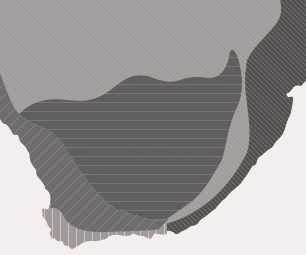






Rate this article
Article well written and informative
Rate this plant
Is this an interesting plant?
Login to add your Comment
Back to topNot registered yet? Click here to register.